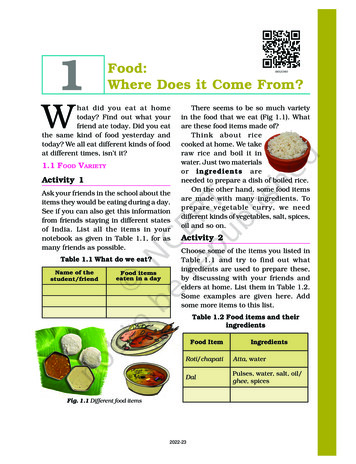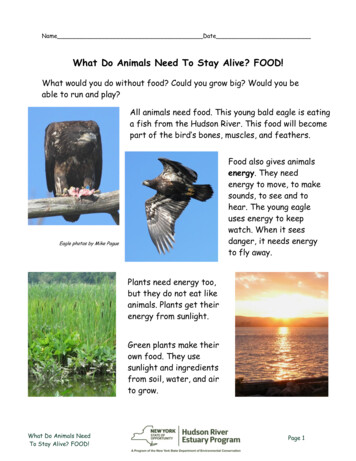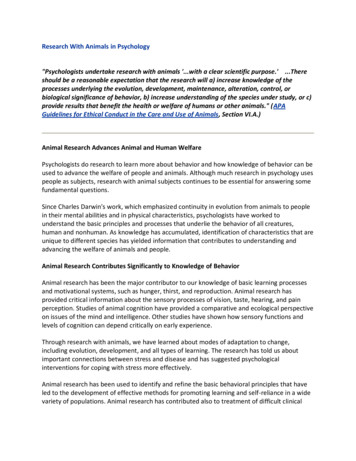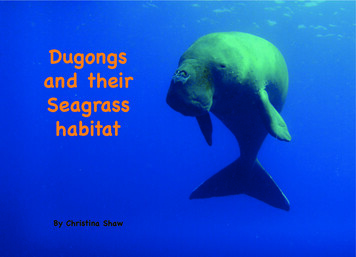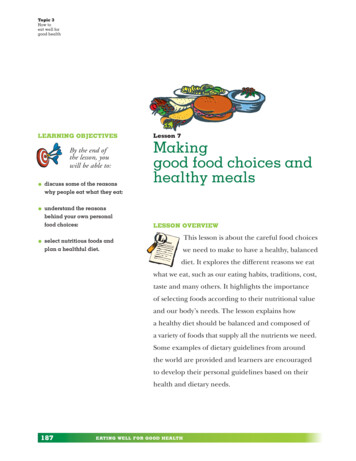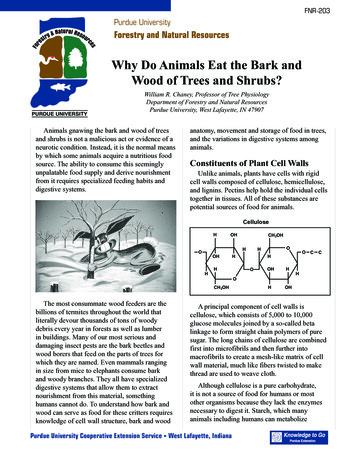
Transcription
FNR-203& Natural ResoutryrseForestry and Natural ResourcessceForPurdue UniversityWhy Do Animals Eat the Bark andWood of Trees and Shrubs?PURDUE UNIVERSITYWilliam R. Chaney, Professor of Tree PhysiologyDepartment of Forestry and Natural ResourcesPurdue University, West Lafayette, IN 47907Animals gnawing the bark and wood of treesand shrubs is not a malicious act or evidence of aneurotic condition. Instead, it is the normal meansby which some animals acquire a nutritious foodsource. The ability to consume this seeminglyunpalatable food supply and derive nourishmentfrom it requires specialized feeding habits anddigestive systems.anatomy, movement and storage of food in trees,and the variations in digestive systems amonganimals.Constituents of Plant Cell WallsUnlike animals, plants have cells with rigidcell walls composed of cellulose, hemicellulose,and lignins. Pectins help hold the individual cellstogether in tissues. All of these substances arepotential sources of food for animals.CelluloseThe most consummate wood feeders are thebillions of termites throughout the world thatliterally devour thousands of tons of woodydebris every year in forests as well as lumberin buildings. Many of our most serious anddamaging insect pests are the bark beetles andwood borers that feed on the parts of trees forwhich they are named. Even mammals rangingin size from mice to elephants consume barkand woody branches. They all have specializeddigestive systems that allow them to extractnourishment from this material, somethinghumans cannot do. To understand how bark andwood can serve as food for these critters requiresknowledge of cell wall structure, bark and woodA principal component of cell walls iscellulose, which consists of 5,000 to 10,000glucose molecules joined by a so-called betalinkage to form straight chain polymers of puresugar. The long chains of cellulose are combinedfirst into microfibrils and then further intomacrofibrils to create a mesh-like matrix of cellwall material, much like fibers twisted to makethread are used to weave cloth.Although cellulose is a pure carbohydrate,it is not a source of food for humans or mostother organisms because they lack the enzymesnecessary to digest it. Starch, which manyanimals including humans can metabolizePurdue University Cooperative Extension Service West Lafayette, Indiana
because they produce amylase enzymes, is similarto cellulose except the long chains of glucose arelinked in an alpha configuration. Cellulose has asmuch food value as starch, but only animals thatmaintain colonies of microorganisms in their gutthat produce the enzyme cellulase are capable ofdigesting it.A second important constituent of plant cellwalls is hemicellulose, which bonds cellulosefibrils together. Hemicellulose also is a polymer,but it’s more complex than cellulose because themolecule is highly branched instead of straightchained and consists of a mixture of several kindsof sugars. Only animals with microorganisms intheir gut that produce hemicellulase enzyme canuse this substance as food.Lignin,occurring withinthe cell wallmatrix formedby cellulose andhemicellulose,serves as abinding agentto hold the cellstogether and imparts rigidity to tissues. The softnature of cotton, practically pure cellulose, is anindication of how flexible wood would be withouta stiffening ingredient like lignin. Lignin is acomplex polymer built of phenylpropane units.Due to its phenolic nature (phenols are often usedas disinfectants), lignin tends to make wood lessdigestible even for animals adapted to feeding onwoody tissues.LigninThe middle lamella located between cellsfunctions somewhat as a cementing material tohold adjacent cells together. It consists of pectinsand pectic acids that upon breakdown yieldgalacturonic acid and the sugars arabinose andgalactose.Bark AnatomyBark consists of accumulations of crushed,dead cells of the outer bark and the inner barkof living cork cambium and functional phloemtissues that transport sugars throughout trees. Thethickness and appearance of bark varies widelyamong different kinds of trees and depends on therelative activity of cork cambium and the amountof fibers produced in the phloem. The dead outerbark, regardless of its thickness, is the leastpalatable because the cell walls are high in lignin,phenols, and the waxy substance suberin.The inner bark, in contrast, has living cellswith nutrient laden cell sap, organelles, and storedstarch. Most importantly, the phloem cells withtheir sugary contents are located here. The innerbark is the chief target for animals that feed onbark. Young twigs and branches are preferredbecause they have a higher proportion of innerto outer bark and lower concentrations of antidigestion compounds such as lignin and phenols.There are considerable differences among speciesof trees, but all barks contain sugars, starch,cellulose, hemicellulose, and mineral elements.Wood StructureThe functional xylem or wood of trees extendsfrom near the tips of twigs to near the tips ofroots. When mature, the water conducting xylemvessels and tracheids are dead and hollow. Theonly nutritional value of these cells is in thelignified cell walls. The xylem also containsparenchyma cells that constitute the vascular raysas well as being located around vessels, at theboundaries between annual rings, or just scatteredamong the vessels and tracheids. In the functionalAll of these cell wall materials are potentialsources of food if the proper enzymes areavailable to digest them into their basic sugar andorganic acid components.Relative position of bark and xylem tissues in a tree trunk2
The vascular cambium is the lateral meristemfrom which both new xylem and phloem cellsarise. The succulent, expanding new xylem andphloem cells produced by the vascular cambiumbecome a sink for sugars and amino acids, makingthem particularly attractive as a food source.Movement and Storageof Food in TreesSome of the sugar produced by photosynthesisis used for growth at its site of synthesis, butmost is transported via the phloem to other sitesto sustain growth or for storage in the branches,trunk, fruits, and roots. The phloem, located inthe inner bark, extends throughout trees fromthe small twigs in the crown to the fine roots.Analysis of the watery sap coursing throughthe cells of the phloem reveals that sucrose isthe principal form in which photosynthate istranslocated, but sorbitol, mannitol, raffinose,stachyose, verbascose, and even amino acidsalso occur. Surplus quantities of these sugars arestored in living parenchyma cells in the roots andin the sapwood of the branches and trunk of trees,usually as starch. Renewal of tree growth in thespring is dependent on this stored food, which atthe same time can also be a rich source of easilydigestible food for consumers of the bark andwood.For carnivores and omnivores adapted toeating meat as well as fruits and nuts with theirconcentrated food value, the digestive systemis relatively simple. Strict herbivores have a bigchallenge since the vegetation they consumeis a far less concentrated food, more difficultto digest, and often protected by defensivecompounds. In addition, the rigid cell walls ofplant material must be broken down to gainaccess to proteins and carbohydrates insideliving cells.For animals, the breakdown of foodstuffs isaccomplished through a combination ofmechanical grinding and enzymatic processesbeginning in the mouth. To further degradeingested food, the digestion system of herbivoresis uniquely modified. It varies considerablyamong species, but in all cases depends onmicroorganisms that inhabit special compartmentsof the stomach (rumen), intestines (cecum, an outpocketing of the terminal portion of the smallintestine where it joins the large intestine), anexceptionally long intestine, or an enlarged colon.Protozoa and bacteria that function similarly tomicroorganisms that degrade woody debris in theoutside environment by secreting digestiveCopyright W.H. Freeman and Company/Worth Publisherspart of the xylem, the sapwood, parenchymacells are alive and used for storage of starch. Theheartwood, in contrast, has no living cells andthe starch is replaced with resins and phenols thatdeter fungal decay and insect feeding. Hence,the sapwood is the most appealing and digestiblepart of the xylem for wood feeders with its storedstarch and water conducting cells containing onlysmall amounts of anti-digestion compounds.Digestive SystemsTo use bark and wood as food, organismsmust possess specialized digestive systemsand the necessary enzymes. The functionof these adaptations is to break down hugemacromolecules (proteins, fats, starch, cellulose,and hemicellulose) into smaller molecules (aminoacids, fatty acids, and sugars) that canbe absorbed into the circulatory system.Hindgut fermenter with cecum3
Copyright W.H. Freeman and Company/Worth PublishersStomach of foregut fermenterenzymes are brought “indoors” to the protectionof the gut. There they basically conduct the samefermentation processes. The cellulases, hemicellulases, and other enzymes that they produce,release sugars, organic acids, and amino acidsfrom woody materials, nourishing both the hostanimal and the millions of microorganisms livingin its digestive system.The stomach of herbivorous animals can bea single saclike compartment (monogastric) orcomplexly subdivided into various chambers(digastric). In monogastric herbivores suchas horses, rhinoceroses, rodents, and rabbits,protein is digested and absorbed in the singlechambered stomach. Cellulosic material isdigested by microorganism-aided fermentationin the intestine, often modified to have either acecum or enlarged colon. In these animals theintestine is very long, often 25 times the bodylength, to insure adequate time for digestion andabsorption. Monogastric animals that have theability to digest cellulosic materials are referred toas hindgut fermenters.In digastric animals like deer, antelope,moose, camels, sheep, goats, and cattle, thestomach is divided into four chambers, the firstbeing the rumen which contains the symbioticmicroorganisms. Digastric animals only partiallychew their food as they quickly gather it. Laterwhen resting and watchful for predators, theyregurgitate and re-chew it. This cycle is repeated4until the mechanical and chemical breakdownof the food is adequate for it to pass to the nextchamber of the stomach. Digastric animals arecalled foregut fermenters.Several hindgut fermenters (rodents, rabbits,and others) increase the digestion of their foodby eating 25 to 60 percent of their feces. Thispractice, known as coprophagy, is important forsmall mammalian species with relatively highmetabolic rates and sustained caloric needs.The first pass of food through the digestivetract does not provide enough opportunityfor microorganisms to digest the coarse foodparticles. Coprophagy is somewhat analogousto a ruminant animal chewing its cud, thedifference being the point in the digestion processat which the food is rechewed. Animals thatpractice coprophagy usually consume their feceswhen resting.Examples of Animals thatEat Bark and WoodBeavers are a good example of a hindgutfermenter. They are primarily bark-eaters,ingesting the bark of young twigs and sapwoodof branches and small tree trunks. In the springand fall, about half of the beaver’s food is woodyvegetation, but in winter it feeds on woodyvegetation almost exclusively. They actively cuttrees and shrubs in the summer, storing sectionsof the wood under water as a winter food supplybeneath the ice.Beavers have many adaptations for theirwoody diet. Large jaw muscles power sharpTrees cut by beavers for food and dam construction
incisors that slice through wood and flat molarsgrind the fibrous bark. Their large cecum containsbacteria and fungi that aid in digesting about 30percent of the dietary cellulose. To improve theextraction of nourishment from wood and bark,beavers practice coprophagy, thereby runningfood through their digestive system several times.Rabbits have a simple stomach, but anenlarged cecum and colon inhabited by symbioticmicroorganisms allow digestion of theirherbivorous diet. Particularly in winter whenother sources of food are scarce, rabbits maygnaw the bark of trees, creating consternationfor homeowners, foresters, nurseryman, andChristmas tree growers. Rabbits practicecoprophagy, allowing them to meet theirnutritional requirements in spite of the fast transittime of food through their digestive system.Coprophagy increases protein digestibility from50 percent in one pass through their digestivesystem to 75 to 80 percent upon re-ingestion.Cellulose digestion is increased from 14 percentin one pass through their digestive system to twoor three times that amount when the feces isre-ingested.In summer, porcupines feed on groundvegetation, but in the winter, they spend mostof their time in trees eating the inner bark andtwigs from a great variety of species, makingthemselves a pest in the opinion of most treeand shrub owners. Much of the damage is dueto girdling the base of seedlings and saplings, aswell as from deforming the growth of young treesby randomly pruning branches as they feed.To digest the high percentage of fiber in theirdiet, porcupines are equipped with a cecumhousing cellulase- and hemicellulase-producingmicroorganisms. In addition, porcupines have 20teeth to reduce their food to dust-like consistencyfor efficient breakdown. The large intestine also isextremely long, resulting in a slow passage timeand more absorption of the fermented products ofthe cecum.Ruminants with chambered stomachs andforegut fermentation are represented by a largenumber of animals that dominate woodlands andprairies. Deer and moose are just a couple ofexamples.The herbaceous diet of deer frequently includesthe foliage and twigs of woody plants that theychew just enough to swallow. After a deer fillsits rumen, the first chamber of its stomach, itlies down in a secluded place to regurgitate andchew its cud, re-swallowing the food for furthermicrobial fermentation and eventual passage tothe second portion of the stomach, the reticulum.After about 16 hours, food passes to the thirdchamber, the omasum, where intensive digestionand absorption take place. The last compartment,the abomasum, produces acid to break down foodpieces for easier absorption of nutrients in theintestines.The diet of moose includes leaves of treesand shrubs and both terrestrial and aquatic plantswhen available. During the winter months theirfood becomes even more woody, consistingalmost solely of 30 to 45 lbs of twigs and shrubseach day. As food becomes scarce in late winter,moose will strip bark from trees, especiallypoplars. Like deer, the ruminant digestive systemof moose extracts sustenance from these woodytissues.Bark stripped from sapling by porcupineIt should now be apparent that tree bark andwood are important sources of food for manyanimals with feeding habits and digestive systemsadapted to capitalize on their food value.5
8/2003It is the policy of the Purdue University Cooperative Extension Service, David C. Petritz, Director,that all persons shall have equal opportunity and access to the programs and facilities without regard to race, color, sex, religion, nationalorigin, age, marital status, parental status, sexual orientation, or disability.Purdue University is an Affirmative Action employer.This material may be available in alternative p://www.ces.purdue.edu/extmedia
Eat Bark and Wood Beavers are a good example of a hindgut fermenter. They are primarily bark-eaters, ingesting the bark of young twigs and sapwood of branches and small tree trunks. In the spring and fall, about half of the beaver's food is woody vegetation, but in winter it feeds on woody vegetation almost exclusively. They actively cut


